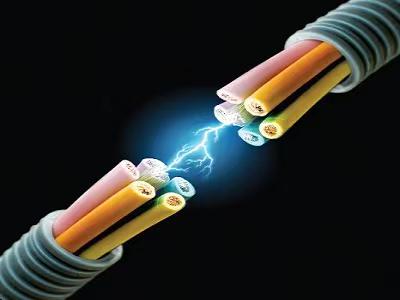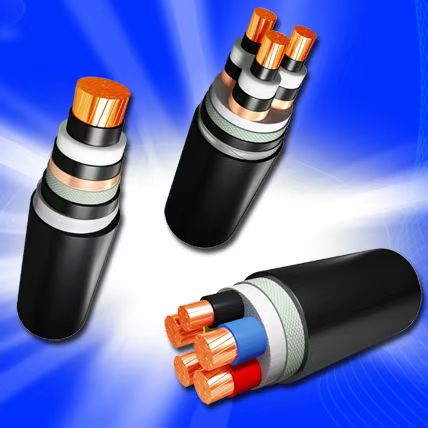

Stromkabel werden gewöhnt elektrische Energie übertragen und verteilen. Stromkabel werden häufig in städtischen unterirdischen Stromnetzen verwendet, Stromerzeugungsleitungen von Kraftwerken, interne Stromversorgung von Industrie- und Bergbauunternehmen, und Unterwasserübertragungsleitungen über Flüsse und Meere.


Der innerste Teil des Stromkabels ist der Kabelkern (Dirigent). Die Außenseite des Drahtkerns ist Phasenisolierung und Packung, und das Äußere ist eine dreiphasige integrierte Isolierung. Der äußere Teil der integrierten Isolierung ist die Bleiumhülle, und der äußere Teil der Bleihülle ist eine Schutzschicht wie Stahlpanzer und PVC -Verschiebung.
Zum Beispiel, Die Struktur von Yjqoz220/1 × 800 vernetzter Kabel von innen nach außen ist: Dirigent, Halb-leitendes Band, Leiterschirmtätigkeit, Isolierung, Isolationsschirdierung, longitudinale wasserblockierende Schicht, Hülse führen, Asphalt, PVC -Band, PVC-Scheide und halbkonditionelle Beschichtung.
Der Mindestbiegeradius des Kabels hängt mit seinem Durchmesser zusammen, und der zulässige Biegeradius wird als ein Vielfaches des Kabeldurchmessers ausgedrückt, nicht weniger als 15 Zeiten für das Drei-Kern-Öl-Isolierkabel und 25 Zeiten für das Single-Core-Kabel. Die äußere Länge des ölgetränkten, isolierten, von Blei bedeckten Kabelns ist 30 Zeiten, in denen es über 40 mm ist und 25 Zeiten, in denen es unter 40 mm ist. Gummi, Kunststoffisoliertes Kabel Ist 10 mal.
Nach dem Brauch im In- und Ausland, Das Kabel ist in niedriges Spannungskabel unterteilt, Mittelspannungskabel, Hochspannungskabel und ultrahoch-Spannungskabel, das ist, Die Spannung beträgt 35 kV und unten für niedrige Spannungskabel; Medium voltage cable above 35kV — 69kV; 110-220KV -Hochspannungskabel; Mehr als 220 kV werden als Ultrahosen -Spannungskabel bezeichnet.
Die Abschirmschicht ist in innere Abschirm- und Außenschirmtätigkeit unterteilt. Sie sollen den Kabelleiter und die Isolationsschicht herstellen, Die Kabelisolierungsschicht und die innere Hülle haben einen guten Kontakt, Beseitigen Sie die Erhöhung der durch die Leiteroberfläche verursachten elektrischen Feldstärke der Oberfläche, und die Innenscheideoberfläche ist nicht glatt, Im Allgemeinen ist auf der Oberfläche des Leiters mit metallischem Papierband oder Halbleiterpapierband bedeckt.
Das Kabel ist mit Erdungskabel installiert, hauptsächlich zum Schutz des Isolationsausfallfehlers tritt im Kabel oder durch einen großen Fehlerstrom im Drahtkern auf, Die induzierte Spannung der Metallscheide kann den Abbau des Isoliers machen, Arc verursachen, Die Metallscheide brennt durch.
Die Kabel -Außenhülle besteht im Allgemeinen aus einer inneren Auskleidung, eine gepanzerte Schicht und eine äußere Abdeckungsschicht. Die Auskleidung befindet sich zwischen der gepanzerten Schicht und der Innenscheide und ihre Funktion besteht darin, die Innenscheide vor Korrosion zu schützen und zu verhindern.
Gepanzerte Schicht außerhalb der Auskleidungsschicht, Seine Funktion besteht darin, den Effekt der mechanischen Kraft auf das Kabel zu verringern, so dass die mechanische Kraft auf dem Kabel von der gepanzerten Schicht getragen wird. Die äußere Abdeckungsschicht befindet sich außerhalb der gepanzerten Schicht und ihre Funktion besteht darin, zu verhindern, dass die gepanzerte Schicht erodiert wird. Deshalb, Die Rolle der Außenhülle der Kabel besteht darin, die Innenscheide vor äußeren Einflüssen und mechanischen Schäden zu schützen.
Gemäß dem Betrieb oder dem vorbeugenden Test des Stromkabels, das Kabel, Kabelkopf und Zwischenbox zeigen unterschiedliche Eigenschaften von Isolationsschäden, die in drei Arten unterteilt werden können: Sprengfehler, Aufschlüsselungsfehler und Betriebsfehler.
Schießprobleme
In Industrie- und Bergbauunternehmen, Der Betrieb von Stromkabeln, wegen verschiedener Faktoren, Die Isolierung ist schwer beschädigt, Das Ereignis des Auslösens. Es heißt Kabelfeuerung.
Die Eigenschaften dieser Art von Fehler sind: Kabelfehlerpunkte sind meistens Bleipack oder Kupferruptur, Die externe Verformung ist nicht gleich; Kabelfehlereigenschaften manifestiert sich häufig als zweiphasige Kurzschluss-Erdung oder zweiphasige Leitungsbrechung und Erdung, Der Erdungswiderstand ist normalerweise klein, Den Fehlerpunkt analysieren, kann festgestellt werden.
Aufschlüsselungsfehler
In der Praxis, Die durch vorbeugende Tests ausgelöste Kabelisolierungschaden wird üblicherweise als Kabelbaus als Kabelbaus bezeichnet. Solche Fehler treten bei Gleichstrom -Testspannung auf, und der Isolationsschäden ist der elektrische Zusammenbruch. Die Adresse ist normalerweise ohne Blei oder Kupfer, Und es gibt keine signifikante Verformung draußen (mechanische Wunde draußen).
Kabelbannungsfehler sind meistens einfache Erdungsfehler. Die Erdungsfehler sind hoch. Fehlerpunkte analysieren, Isolationsmaterialien haben keine Karbonisierungspunkte, Aber Carbonlöcher und Wasserzweig -Alterungsstrukturen können vom Instrument gefunden werden. Für Kabelbrotverfehler, insbesondere einige hochauflösende Erdungskabel-Breakdown-Fehler, Die Schwierigkeit des Tests reicht aus.
Betriebsproblem
Es bezieht sich auf das in Betrieb, Kabellinie, Motor, Transformatorkabelblei, Die Hochspannungs -Sekundärschleife präsentieren Spannungsschwankungen oder finden Sie das Erdungssignal, Fegen Sie die Möglichkeit anderer Stromkomponenten weg und schließen Sie den Kabelfehler ab.
Der Stab des Kabellanbetriebsfehlers ist das Kabelschuss (wie zwei Erdungspunkte, die durch Kurzschluss zwischen den Phasen verursacht werden); Ein weiterer Betriebsfehler werden zu Kabelbausbannungsfehlern entwickelt (wie Kabelalterung, Isolationsfehler, usw.) Bei Stop -Point -Inspektion aufgrund des Spannungswiderstandes.
Es gibt auch einige Kabelbetriebsfehler. Nach dem Kabel Stromausfall, Die Messung der Isolationsresistenz und der DC -Spannungstest können ordnungsgemäß getestet werden, und dann Das Kabel wird in das System eingegeben.
1. Weil die Laufzeit des Kabels länger ist, Die Isolationsschicht zeigt eine natürliche Alterung
2. In einer ätzenden Umgebung, Die Kabelscheide wird schnell beschädigt, und das ätzende Gas eindringt in die Isolationsschicht, um sie zu verschlechtern. Unabhängig von der Alterung oder Verschlechterung der Kabelisolierung, Die Breakdown -Spannung nimmt ab, und führen schließlich zur Abnahme der zusätzlichen Leistungsfrequenzspannung.
1. Aluminiumlegierungsleiter sollte nicht für Kabel mit Spannungsgrad über 1 kV ausgewählt werden.
2. Vernetzte Polyethylen- oder PVC-extrudierte Isolierungstyp sollten für Niedrigspannungskabel verwendet werden. Wenn Umweltschutzanforderungen erfüllt sind, PVC -isolierte Kabel sollten nicht verwendet werden.
3. Hochspannungs -Wechselstromkabel sollten mit XLPE isoliert werden.
4. Mobile elektrische Geräte und andere biegen sich häufig und bewegen oder haben eine höhere Flexibilitätsanforderungen für die Schleife, sollten Gummi -Isolierkabel verwendet werden.
5. Gemäß den Anforderungen des Isolationstyps, Für die Strahlungsstelle sollte vernetzte Polyethylen- oder Ethylenpropylen-Gummi-Isolationskabel mit Strahlungswiderstand ausgewählt werden.
6. 60℃ Über hohe Temperaturorten sollten nach hoher Temperatur sowie der Anforderungen an die Dauer und Isolierung ausgewählt werden, hitzebeständiges Polyvinylchlorid, Vernetzte Polyethylen- oder Ethylenpropylen -Gummiisolierung und andere hitzebeständige Kabel; Mineral isolierte Kabel sollten in hoher Temperaturumgebung über 100 ℃ verwendet werden. Polyvinylchlorid -isolierte Kabel sollten nicht an Hochtemperaturorten verwendet werden.
7. Wenn die jährliche Mindesttemperatur unten liegt -15 ° C, Vernetztes Polyethylen, Polyethylen- und kaltresistente gummisolierte Kabel sollten gemäß den Bedingungen mit niedrigen Temperaturen und den Anforderungen des Isolationstyps ausgewählt werden. PVC-isolierte Kabel sollten nicht in der Umgebung mit niedriger Temperatur verwendet werden.
8. An überfüllten Orten oder Orten mit geringer Toxizitätsanforderungen, Halogenfreie isolierte Kabel wie vernetzte Polyethylen oder Ethylenpropylenkautschuk sollten anstelle von Polyvinylchlorid-isolierten Kabeln verwendet werden.
9. Für die vernetzten polyethylenisulierten Kabel von 6kV und höher, Die innere und äußere semi-leitende Abschirmschicht und die Isolierschicht der dreischichtigen Coextrusionsprozesseigenschaften sollten ausgewählt werden.
10. Ein-Kern-Stromkabel des Wechselstromsystems, Wenn es notwendig ist, den Kabelwiderstand gegen externe Kraft zu stärken, sollte eine nichtmagnetische Metallpanzerungsschicht wählen, Nicht ohne nichtmagnetische wirksame Behandlung von Stahlpanzer.
11. Das U -Boot -Kabel sollte verzinkter Stahldraht sein, Edelstahldraht oder Kupfer mit guter Korrosionsbeständigkeit, eher als Aluminium gepanzert.
12. Die Brandschutzverteilungsleitungen erfüllen die Bedürfnisse der kontinuierlichen Stromversorgung im Falle eines Brandes, und ihre Verlegung muss den folgenden Anforderungen entsprechen:
Für offene Anwendung (einschließlich der Legung in der Decke), Metallkanal oder geschlossener Metallnutkasten sollte zum Schutz getragen werden, und Brandschutzmaßnahmen sollten für den Metallkanal oder die geschlossene Metallnutkiste ergriffen werden.
Wenn flammhemmende oder feuerresistente Kabel verwendet und in Kabelbrunnen und Gräben gelegt werden, Metallkanal oder geschlossener Metallnutbox -Schutz ist nicht erforderlich; Bei der Verwendung von nicht brennbarem mineralisch isoliertem Kabel, Es kann direkt angewendet werden.
Für dunkle Anwendung, Die Röhre sollte abgenutzt und in eine nicht brennbare Struktur gelegt werden, und die Dicke der Schutzschicht sollte nicht weniger als 30 mm betragen.
Brandverteilungsleitungen sollten getrennt von anderen Verteilungsleitungen in verschiedenen Kabelbrunnen und Gräben gelegt werden; Wenn es wirklich schwierig ist, es gut in das gleiche Kabel zu legen und Graben zu graben, Es sollte auf beiden Seiten des Kabelsbrunnens und des Grabens angeordnet werden, und die Brandschutzverteilungslinie sollte verwendet werden Mineral isolierte nicht brennbare Kabel.
Wenn Menschen den Begriff mineralisch isoliertes Kabel hören, many immediately think of harsh environments like…
Wenn Telekommunikationsnetzwerke und Stromübertragungssysteme schnell wachsen, the demand for reliable and cost-effective…
In groß angelegten Öl- und Gasprojekten, Industriekabel sind nicht nur Zubehör—they are the "nervous…
In der Welt der elektrischen Verbindungen, Kabelschuhe—auch als Kabelohren oder Kabelklemmen bezeichnet—Sind…
Bei der Auswahl des richtigen Kautschukkabels für ein Elektrotechnikprojekt, it is critical to…
Liebe Partner und Kunden: 29. Januar, 2025 ist das chinesische Neujahr – Spring…